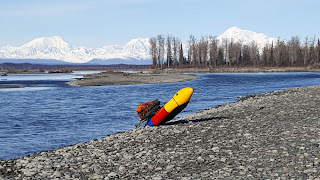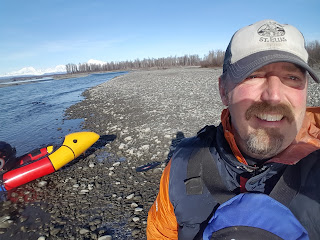Caribou Hunting with a Hot Tent
I bought a camping wood stove last Spring called the Titanium Goat. The main selling point for me was weight; 1 pound 6 ounces for the wood stove and the stovepipe,...not bad. I wanted to add some much needed dry heat to our moose hunting shelter. There have been many years on our hunt when it has rained, snowed or rained and snowed every single day of the trip. I was hoping to be able to dry clothing and warm our bones.
Since we hunt in a non-motorized area weight is always a judicious consideration. In my mind the less-than two pound burden of the stove was so insignificant that it was worth fussing-with and even modifying gear as needed to make room for such a potentially game-changing piece.
 |
| Our moose hunting shelter. The Titanium goat was underpowered to heat this behemoth. |
Although it was a little underpowered for our large moose hunting shelter, I knew that my tiny little Titanium Goat wood stove had its place and I really wanted to bask in the glow of it’s warm embers. It would be especially grand if it were particularly inhospitable outside.
Maybe I could modify my tent.
“I think I want to go hunting this weekend”. I said. Tamra wasn’t sure what I was talking about. “The Nelchina caribou hunt closed on Sept 30th for the rut but it opens back up on October 21st.”
“Okay.”, she said.
I began the process of designing a rain fly stovepipe adapter so I could use my wood stove inside my dome tent. With only two days before I wanted to leave, I began the design process after work. I set up the tent on my frozen lawn.
At this point there were puzzled looks from the wife. Upon completion, I snugged it into place on the rain fly zipper. I crawled into the tent from the other side and fired up the stove. I knew that if the tent smoldered, melted or erupt into dancing flames, it would be a failure and I wanted to find that out in the comforts of my back yard, not in the wilderness several miles from the truck. Luckily none of these things happened. What did happen was the inside of the tent warmed up quickly and life was good. I dubbed it Prototype “A”. It was almost as heavy as the whole stove but it worked, at least on my lawn.
 |
| 1/8 inch aluminum and random hardware found in my garage would help to separate flammable tent material from the hot stove pipe. |
The weather forecast for Cantwell Alaska was clear and cold. How cold I wasn’t sure. At this same time last year it was below zero. My gear was packed; I was ready.
I wanted to take my fat tire bike and cart but the snow was just a little too deep. I opted instead to hike in and pull a plastic sled. I had both loaded in the truck so I would have some flexibility. The orange Paris sled has been with me on many mountain trips and it’s a blessing to be able to get weight off of your back.
 |
| hiking in. |
I split the weight of my camp and hunting kit between my pack and the sled and set off up the trail. It was five degrees Fahrenheit when I left the truck but I had a good pace and was able to stay warm without sweating too much. Before long I set up my camp about five miles-in at a place that, over the years, we have named “Caribou camp”. I wanted to get the most use of the dwindling daylight hours so I didn’t set up camp right away like I usually do. I dumped all unnecessary gear and headed further up the trail. After about an hour I spotted a couple of small caribou grazing in the valley below.
The biologists at The Alaska Department of Fish and Game (ADFG) have been encouraging folks to harvest cows because the herd is exceptionally strong right now and they are worried that they will overgraze their habitat which, in- turn could cause a dramatic crash in the herd. In fact, last year they granted a second permit for any tier 1 Nelchina caribou permit holder to help achieve this goal. I wanted to bag a cow but I’m an opportunistic hunter; I’m not likely to pass up legal game. Know thyself.
I continued down the trail, making myself small trying to avoid giving away my position. I hunkered low as I made my way down the hill toward the cows. Something caught my eye. “Oh shit, there’s a big bull!” I noticed. The bull had been laying low below a small bench. When he saw me sneaking down the hill, he stood up, looked at me and then ran off. Quickly I took off my pack, chambered a round in my 30.06 and waited for my opportunity.
Sure enough he appeared in a small clearing between stands of Willow bushes about 300 yards away. He took pause to turn and look at me and as it turned out this was his last mistake.
 |
| Bull down |
 |
| After one antler broke off, I used it to anchor my rope ratchet to hoist the rear leg. |
 |
| All of the meat fit into my kiddy sled. |
 |
| Titanium goat kicking ass. |
 |
| Hauling meat six miles to truck is a lot easier with a sled and a few down hills runs. |




